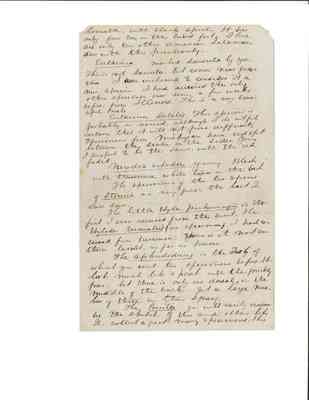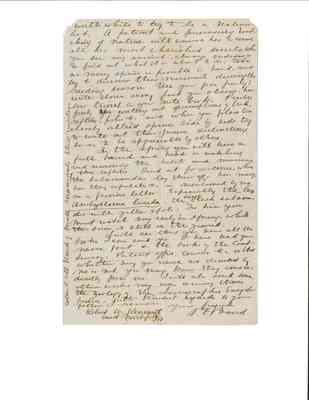Pages
1
November 26, 1853 [stamp] Smithsonian Institution Washington D.C.
My Dear Robert I have had your letter of Nov. 9 for some time in hand, and only waited for the arrival of the keg to answer it. By some unknown delay, this did not come until yesterday, after I had written to the Express agent at Cleveland to know whether a parcel to me had lately passed him. I was much gratified by the contents of the keg which were in first rate order and included a number of most interesting species, many of them for the first time detected in the west. In the enclosed list you will find the names of the [illegible] sent and I will take them up one by one and make some remarks. I have added a sketch of a few, to enable you to identify them. Your No. 1. I could not identify. The paper in which you had wrapped round the specimens was softened and torn in several cases so that I could not repair. No. 2 Chlorosoma vernalis green snake. This I have never received nor known so far west before. 3 Amblystom luridum. The largest salamander. black with yellow spots. This has only been seen in Michigan and Wisconsin heretofore. 4. Notophthalmus miniatus the rough salamander. brick red above, yellowish red beneath, with black specks. Lives under rather dry logs in the woods. Called by Harlan Say Salamandra symmetrica. No. 5 Hemidactylium scutatum This species in the chestnut above, white
2
beneath, with black specks. It has only four toes on the hind foot: There are only two other American Salamanders with this peculiarity. Eutainea. Marked Saurita by you. This is not Saurita, but comes near proxima. I am inclined to consider it a new species. I had received the only other specimen ever seen, a few weeks before, from Illinois. This is a very beautiful snake. Eutainea sirtalis. This species is probably as named, although I do not feel certain that it will not prove different. Specimens from Michigan have red spots between the scales, on the sides. Yours I suspect to be the same, with the red faded. Nerodia sipedon young. Black with transverse white lines on the back. The specimens of the two species of Storeria are very fine: the best 2 ever seen. The little Hyla pickeringii is the first I ever received from the West. The Hylodes Taenialus (one specimen) I had received from Wisconsin: Yours is its most southern limit, as far as known. The Aphredoderus is the Fish of which you sent two specimens before. It looks much like a perch, with the prickly fins: but there is only one dorsal, in the middle of the back. Get a large number of these in the spring. The Paecilia. you will easily recognize by the sketch. Of this and others like it, collect a great many specimens. This
3
worth while to try to be a Naturalist. A patient and persevering watching of nature will cause her to reveal all her most cherished secrets. When you see any animal, always endeavor to find out what it is about to do: take as many species as possible in hand, and try to discover their movements during the breeding season. Use your pen freely: write down every fact you observe, however trivial in your note book. Practice freely the writing out descriptions of but, reptiles, fishes &c. and when you place two closely allied species side by side, try to write out their precese distinctions, so as to be appreciable by others. In the spring you will have a full hand and head in watching and recording the habits and manners of the reptiles. Find out for instance, when the Salamanders lay their eggs, how many, how they copulate &c, as mentioned by me in a previous letter. Especially the large Ambystoma Cureda, the large black salamander with yellow spots. For him you must watch very early in spring, while the snow is still on the ground. I will see that you have all the books I can send you. I have had your name put on the books of the Coast Survey, Patent office, census &c, so that whether any you receive are directed by me or not. You may know they come in, directly from me. I will also send some other works very soon, among them the Zoology of the Iconographic Encyclopedia. With kindest regards to your father I remain your friend S.F. Baird [written vertically along left page margin : collect all kinds of small mammals this winter.]
Robert W Kennicott West Northfield, Ill


